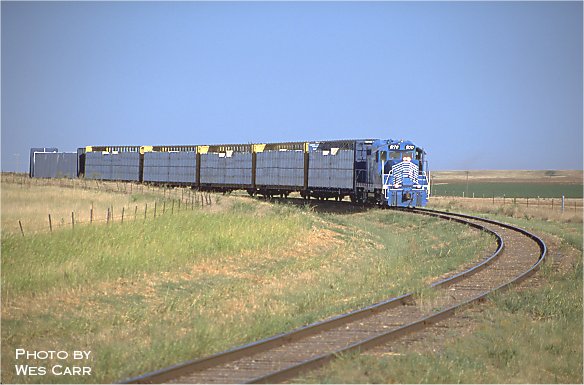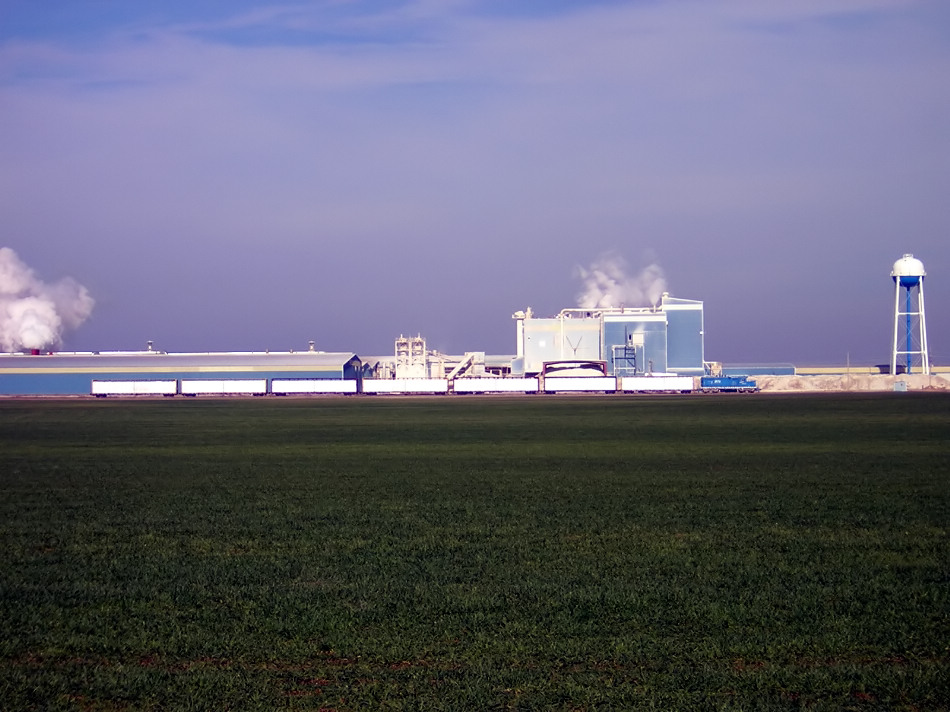I’m a dreamer. I enjoy designing model railroads, exploring new potential prototypes, and even creating freelance or proto-freelance model railroad concepts. I’d like to start slowly sharing some of those ideas here, over time. It would take multiple lifetimes to build all the model railroads that I’d like to build, but perhaps someone else can find some inspiration in these ideas even if I never get around to building them all!
There are some neat short lines in western Oklahoma. One such railroad is the Hollis & Eastern. When the Katy proposed abandoning their branch line from Altus, OK to Wellington, TX in the 1950’s, local businessmen stepped in, buying the line from Hollis to Altus, and naming it the Hollis & Eastern. Into the 70’s it was difficult to tell much difference between the H&E and the Katy days, because the little railroad used a leased MKT GP7. In the 70’s a large gypsum wallboard plant was built in Duke, OK, and the railroad was bought by its new major customer, Republic Gypsum. At some point the tracks between Hollis and Duke were torn up.

I think the first decade of the 2000’s would be the most interesting period on the railroad to model. The line used a single GP10 to make their runs between the wallboard plant and Altus, and used a combination of bulkhead and center-beam flat cars to haul the product. The wallboard cars are interchanged with the BNSF in Altus, and the interchange is accessed via a short portion of the Wichita, Tillman & Jackson RR (the short line successor to what is left of the Katy’s famed Northwest District). The plant also gets single tank cars of some sort of chemical. An SW1 handled the switching of cars inside the plant (as it does to this day). The blue paint scheme really stands out on both locomotives.

The grain elevator in Duke is also an occasional shipper, and these cars were usually UP hoppers interchanged with the WT&J.

Now, to the model railroad. This railroad, despite its small size, needs space to breathe. Rather than try to cram it into a small layout, I designed it with a bit different philosophy. Lets say one had a large bonus room, say 12×18 ft, and wanted to build a large but uncomplicated layout. Lets say they’re like me and enjoy building scenery, weathering rolling stock, and casual operations. Building lots of structures isn’t their thing. This plan has it all for that sort of individual.

I was able to completely replicate the track arrangement in Duke, despite having to wrap it around a curve. The plant could be kit-bashed with Pikestuff components for the most part, and the large steel silos for the elevator could be custom ordered from Iowa Scaled Engineering’s Grainbelt Models division.
The out-of-service elevator at Victory and the long trestle over the meandering, sandy channel of the Salt Fork of the Red River would both be extremely satisfying scenes to model. I decided to represent Altus with staging to save space, so as not to crowd the layout and take from its open feel.
The operations are quite simple. The train takes loads from Duke to Altus, interchanges, and brings back the empties. From there, it does its switching work and ties down. The plant employees use the switcher to shuffle center-beam flats in and out of the plant for loading.

I don’t think this would get boring, other than the limited roster. A back-date to the 90’s, when the primary power was a CF7 would be easy. A back-date to the 70’s when GE center cab switchers were used would also be possible. A back-date to the 60’s with the leased Katy geep is not impossible, but you would need to have the grain elevator scene removable (for older elevators). Also remember that in those days, Duke wasn’t the end of the line.
These days, the H&E still exists but is much quieter. The wallboard company contracted the operation out to Watco’s Stillwater Central RR, and that nifty GP10 is gone. The SW1 is still in the plant. Rail shipments are down, and the Watco crew only drives out once a week or so to work the line. A friend reports that its been several years since the grain elevator has shipped by rail.
Modeling the present day on the line would certainly be interesting, though, as Watco often had a wide-cab ex-CN geep out there as power. They’ve also borrowed a Farmrail locomotive at least once when their locomotive was having trouble.
Hope y’all enjoyed!
Great plan! It is very realistic with plenty of negative space just like the prototype.
LikeLike
thanks just getting ready to downsize and tear down layout the one you propose looks promising again thanku
LikeLike
Nice design, Alex. Being as how I like to sometimes just sit and watch the train go round I personally would add a connection between the two upper curves so a train can go straight across from one side to another. Only used rarely but still would be nice to just sit and watch.,
LikeLike
Hi Alex. I’m a new follower after having recently watched the Small Layouts, Big Opportunities series. I enjoy your posts and I really relate to this one! I too am a dreamer with more ideas for layouts than I’ll ever be able to build. I grew up in Michigan and am still fond of the railroads there despite having lived in Virginia many years now, although I must admit I’ve given some thought to Maryland and Virginia short lines as well. Thanks for sharing your ideas!
LikeLike
This is a great plan!
Just an idea: A continuous-run connection between the turnback curves and through the backdrop would allow a train to roll off a few miles of run before arriving at Duke or the interchange. It could also allow a solo operator to put a “mainline” train into orbit while switching the gyp board plant with the SW1.
The only drawback is that you run the risk of cluttering up the open feel you’ve worked to achieve. I think this could be mitigated using some of the techniques Jason Klocke used on his CGW layout, which you can see at the outset of this video: https://www.youtube.com/watch?v=CdZD6pSZn3Y
I’m really enjoying your posts. Keep up the awesome work!
LikeLike